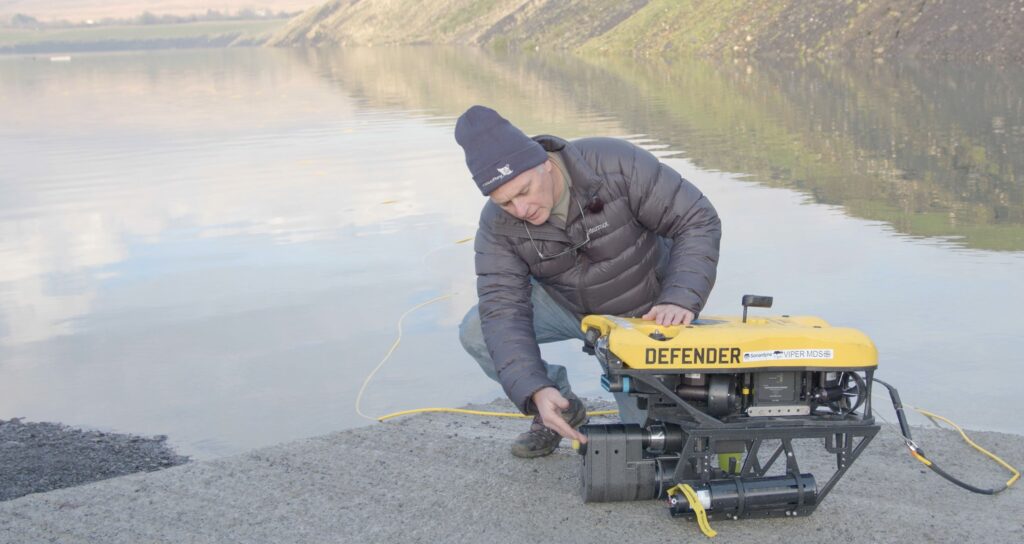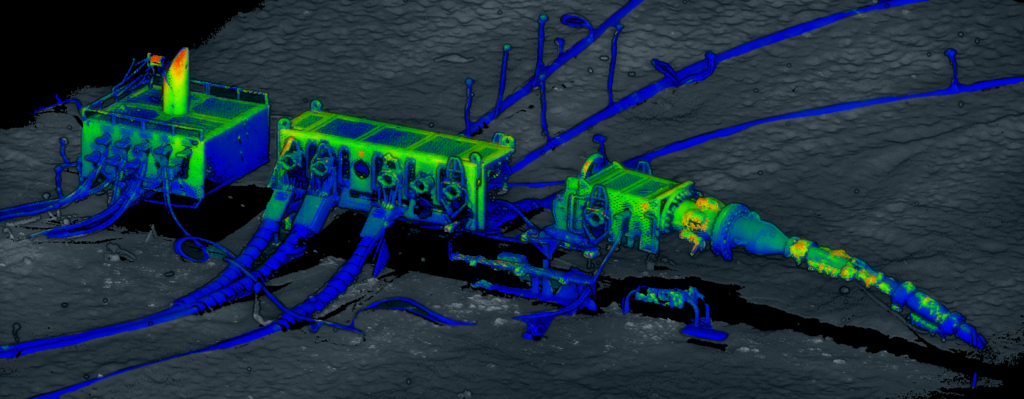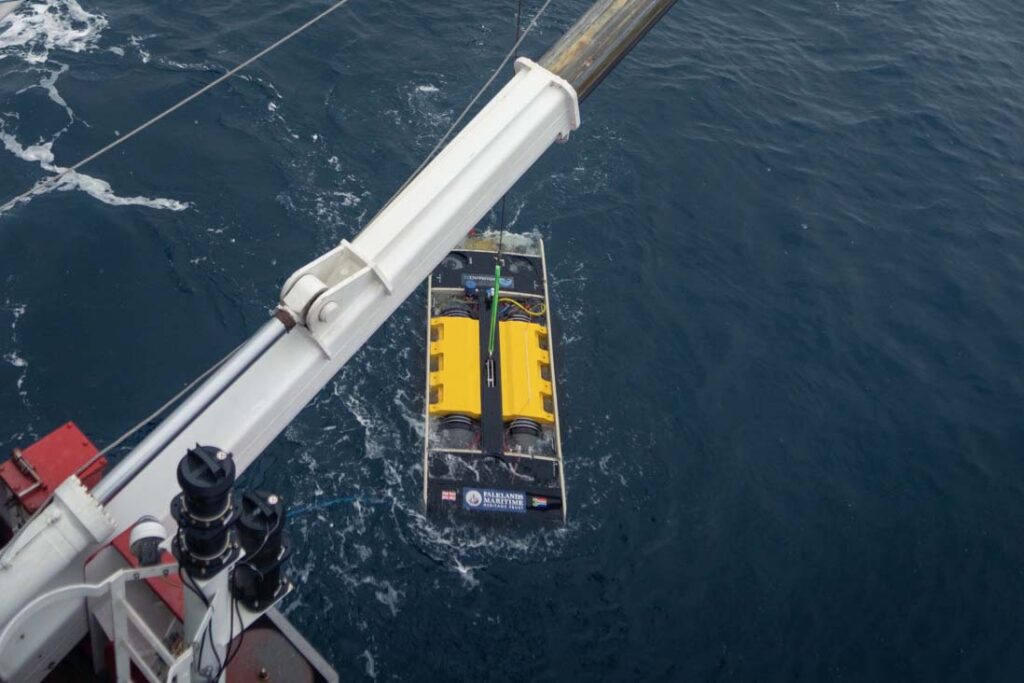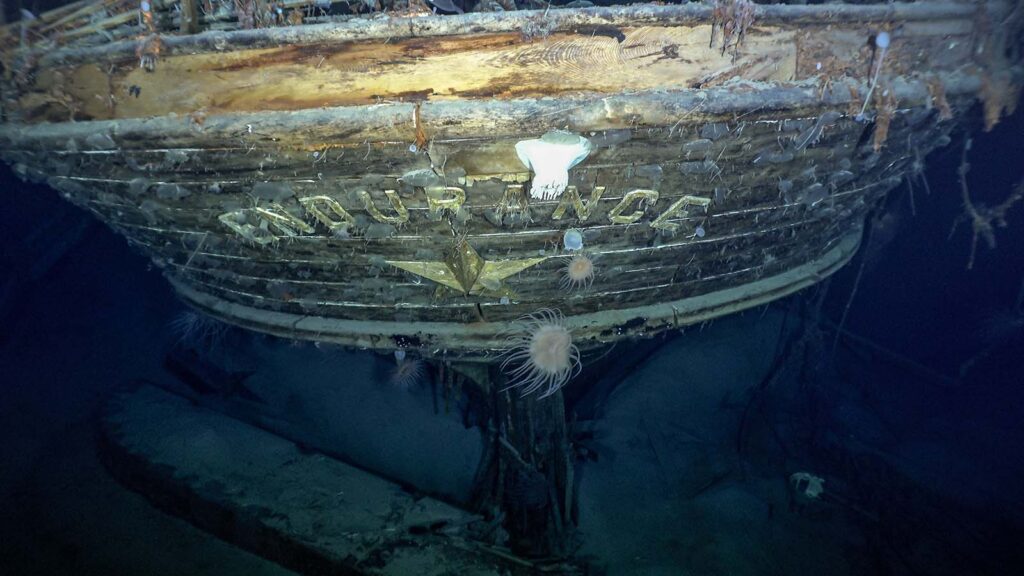Explosive ordnance, such as mines, pose a significant threat to naval operations, offshore energy projects, and other maritime activities. Traditional methods of disposing of these hazards often put personnel and equipment at risk as they require divers or remotely operated vehicles (ROVs) to approach the ordnance closely and manually initiate the detonation process.
The Initiation Transponder 6 (IT 6) from our technology partner Sonardyne, when integrated with mine neutralization devices mounted on a VideoRay Mission Specialist Defender underwater robot, provides a remote, autonomous, safe and effective solution for mine clearance operations. This technical collaboration allows for acoustic initiation and detonation from a remote location, eliminating the need for and risks associated with physical proximity to the ordnance.
The integration of the Defender and mine neutralization devices with the IT 6 represents a significant advancement in the field of explosive ordnance disposal (EOD).

How it works:
- The IT 6 is connected to a non-electric mine neutralization device, which is deployed near the contact by the Defender.
- Once the neutralization device is in place, the Defender can be maneuvered to a safe distance, typically around 1 kilometer away.
- Using Sonardyne’s Wideband 2 digital signal technology, the IT 6 receives an acoustic command to arm the charge from a surface vessel or command center. A subsequent command then initiates the shock tube and detonates the neutralization device.
- The entire process can be carried out in most weather conditions and during day or night, enhancing operational flexibility and safety.
Benefits:
- Enhanced safety: By eliminating the need for physical proximity to the contact during detonation, the combination of the IT 6 and Defender significantly reduces the risk to personnel and assets.
- Increased operational efficiency: The autonomous delivery and wireless initiation capability streamlines the process, allowing for faster and more efficient mine clearance operations.
- Versatility: The IT 6 and Defender can be used in various underwater environments, including deep-water operations, making it suitable for a wide range of clearance missions. The underwater robot is designed for more precise control of the vehicle position and orientation, heavier payloads and demanding interventions. With seven thrusters, it can move in any direction and maintain active pitch to face its target in an upward or downward orientation.
- Proven technology: Sonardyne’s Wideband 2 digital signal technology draws on a fifty-year heritage; it is field-proven, ensuring reliable and long-range underwater wireless communication. The Defender draws on VideoRay’s twenty-five years of ROV design experience and is built with power, reliability and flexibility in mind.
- Multi-shot: the IT 6 can be fired multiple times, making deck tests and practice runs affordable. In addition, if a mission is aborted the kit can be safely recovered and reused. The explosive charge and the IT 6 are only sacrificed on confirmed contacts.
- Cost: Once the initial investment has been made for the technology, the cost per deployment is significantly lower than sending personnel on each mission. If multiple ROVs are deployed, they can be controlled from one vessel or control room, thus further reducing costs.
Demonstration
In 2022, the IT 6 and the Defender were demonstrated together for the first time to the UK’s Defence Science and Technology Laboratory (DSTL) and the UAE Navy at a quarry in Wales.
The demonstration included successful detonations of a mine neutralization device, delivered by the Defender and initiated by the IT 6, from a range of approximately 1 kilometer.
As armed forces around the world move towards more autonomous operations on land, in the air and under the sea, there will be increased demand for the utilization of existing and the development of new technology.
The benefits in terms of safety, efficiency, adaptability and cost are obvious, not just in mine countermeasures; and the collaboration between market leaders, such as Forcys, Sonardyne and VideoRay, will be at the forefront of driving advances in the technology. Contact us to see how we can help you be there too.
_______________________________
Did you know that another of our technology partners, Voyis, manufacture the market’s technically leading ROV piloting camera? The Discovery camera from Voyis enhances your identification by delivering crisp 4K images of your targets in real-time. The ideal complement to the IT 6 and Defender. Find out more in a blog coming soon…
New concepts of operations are emerging which look to increase lethality by leveraging additional sensing capabilities from remote and autonomous systems that operate alongside crewed ships and submarines. The aim is not simply to remove the sailor from the battlefield. Rather, the objective is to deliver increased mission success by providing sailors with additional tools that extend the range of their sensing capabilities, allowing them to gain quick and easy access to actionable data.
Autonomous systems provide a range of capabilities that can deliver persistent underwater surveillance. They can act as the spearhead to a strike group, they can enhance situational awareness by monitoring chokepoints, and they can scale and help extend our reach beyond our own sensing capability.
These concepts require an effective, low probability of intercept and secure network. The solution today is to standardise on one specific supplier using acoustic modems that use the same proprietary protocols. This is not only ineffective, it can compromise security.
Acoustic communication, whilst multifaceted and technically challenging, is both proven and mature. In solving the interoperability problem however, it’s not just about the underpinning technology, but also how industry-academia-government institutions collaborate at the national and international level to address the specific challenges of military communication in the subsea domain. Through this collaborative working, technologies can be developed that will enable interoperability across key operational requirements including secure transmission, multi-user networking, and achieving optimal situational awareness.
In other words, if you want your autonomous underwater vehicle (AUV) systems, divers and submarines to be truly effective and avoid vendor lock-in, you need to come up with a common language.
Dstl has pioneered a breakthrough – Phorcys
The UK Defence Science and Technology Laboratory (Dstl), in conjunction with UK industry partners, including our technology partner Sonardyne, academic partners such as Newcastle University, and the National Cyber Security Centre (NCSC), has been developing a UK government-owned acoustic communication waveform to address the challenges of open, secure and interoperable tactical acoustic communication. This technology, known as Phorcys, will be published as an open standard for worldwide use.
Phorcys works using cryptographic keys that provide two separate layers of encryption for both the waveforms and the data, making it nigh on impossible to break the code. The Phorcys waveform will allow Phorcys equipment vendors to certify equipment, and so provide truly secure and interoperable acoustic communication. Users will select their own keys thus ensuring only they can communicate with their assets.
There is no single operating frequency that meets the many and disparate user requirements for tactical acoustic communication. Acoustic frequency determines range, with lower frequencies providing longer ranges. The Phorcys waveform standard spans three frequency bands to provide a trade-off solution space spanning ultralong range, over 15 nautical miles, command, and control (C2) i.e., asset ‘paging’, medium range, up to 15 nautical miles, command control and communication (C3) applications, and short-range, up to three nautical miles, C3 applications. A key consideration in this multi-band approach to subsea acoustic communication is the fact that size, weight and complexity is driven by the acoustic transducer and not the software or hardware responsible for generating and receiving the acoustic signals.
Making Phorcys work requires a single consolidated software-defined modem (SDM) architecture, separably configurable for each band and transducer. This SDM needs to be hosted in a range of platforms. The integration of open secure waveforms and flexible SDM architectures is arguably the key step towards unlocking true interoperability in the underwater domain.
Where are we now? What’s next?
A recent trial off the coast of Portugal demonstrated a secure data exchange between a submarine and its support vessel at range. This was the first time an acoustic data exchange, using modern cryptographic principles, had been transmitted from a submarine.
At Forcys, our aim now, working alongside our technology partners, is to enable Phorcys certified systems to be supplied as standard on commercial-off-the-shelf (COTS) platforms. These systems are already integrated across the underwater domain on unmanned underwater vehicle (UUV) systems, diver hand-held devices and swimmer delivery systems. The benefits from upgrading them to this new standard will deliver immediate effect.
If you would like to find out more about acoustic communications or want to be a partner in delivering interoperability, please get in touch.
Beluga whales spying, cabled infrastructure sabotage, and nuclear-powered underwater drones in actual development. Recent events in the public domain demonstrate that near peer adversaries have continued to innovate, delivering new technologies and employing new methods in seeking to improve their underwater domain capabilities.
This is not surprising. Globally, critical infrastructure such as fibre cables that are used to enable your internet connectivity, as well as oil and gas pipelines, and offshore renewable infrastructures – to name but a few – all sit on the seabed. In case of conflict, damaging that infrastructure could severely impact national safety, security and integrity.
What does this mean for you? In simple terms; the threat is evolving, and your defences need to be able to identify, plan for and counter them.
In recent conflicts, a growing number of flying drones have made a significant impact when facing conventional armour, ground defences and troops. Alongside the development in unmanned air threats, industry has come up with many disruptive technologies to counter growing drone threats.
But, what does the threat in the underwater environment look like? Is it autonomous and uncrewed? To date, autonomy in the subsea domain has increased both in terms of threats and countermeasures. In developing countermeasures, leading universities have looked at initial concepts for underwater autonomy and have developed guidance systems which enabled them to follow pre-set waypoints and gather data optimally. Some systems have shown that they can adapt to the environment. Already, many systems have transitioned in support of missions like mine warfare.
Moving forwards, arguably what is really needed is to find innovative uses for the disruptive tools that are already at your disposal.
What’s the end game?
If you follow current trends there is likely going to be fewer sailors at sea in the future, but this does not mean replacing man with machine. In fact, this creates the opportunity for naval forces to be far more lethal, employing manpower where it is most needed, having been freed from operations that can be carried out autonomously. Operating from smaller ships and subs, they will be supported by sailors working remotely from headquarters and will jointly command flotillas of robots. These robots will come in all shapes and sizes and work across the whole underwater domain. They will be intelligent, they will be quick to react to certain sensor data, and they will have the ability to support strategic decision-making.
What tools can you count on?
Forcys, in conjunction with our technology partners, are delivering the capability to both the commercial sector and today’s warfighters. Here are three examples of the work we are doing:
Counter-UUV systems
Sentinel is the leading underwater counter-drone capability. Developed originally to detect, track and classify combat divers, it’s now also capable of tracking underwater drones.
Seabed-to-shore connectivity
Forcys’ technology partner Sonardyne leads the world in the development of underwater instruments used to position, sense and communicate. Battery operated, these instruments can be deployed for many years and used to monitor their vicinity. They can work as part of a network. They can interact with underwater vehicles too, using secure acoustic or optical communications. In the littoral, using an innovative buoy design, such as our technology partner EIVA‘s ToughBoy, as a gateway, the underwater instruments could be connected to shore in real-time. In deeper waters an uncrewed surface vessel can be used to harvest data from these instruments at agreed intervals. Easy to deploy and recover, they provide persistence surveillance where it is needed.
Underwater vehicle payloads
Used to improve situational awareness, these payloads can be integrated with autonomous vehicles or swimmer delivery systems to gather better, higher resolution data of the environment. This capability is crucial to help survey the seabed and infrastructure. Helping you to make better decisions faster, Forcys’ technology partner Wavefront Systems‘ Solstice is a multi-aperture sonar used to find mines and other mine-like objects across a wide swath, while our technology partner Voyis‘ Recon AUV is a laser scanner and optical system used to identify them with a high level of fidelity.

In brief
After more than 100 years lost and more than 3,000m underneath sea ice in the Antarctic’s Weddell Sea, the almost fully intact wreck of Ernest Shackleton’s Endurance has been found, supported with technology from Forcys’ technology partners. The Endurance22 expedition set out to locate the vessel, organised and funded by the Falklands Maritime Heritage Trust.
The challenge
The pioneering search saw the Endurance22 team deploy Saab Seaeye Sabertooth hybrid autonomous underwater vehicles (AUVs) from the icebreaking polar supply and research ship S.A. Agulhas II. The main challenges in the search centred around the extreme depths and under-ice conditions the teams were working in.
The solution
During their hunt of the seabed, close to where the 1914-1917 expedition came to its end, underwater robots used our technology partner’s Sonardyne’s navigation instruments to help localise the robot while it conducted the search at significant depth. The robot combined inertial navigation systems with very accurate short base line positioning from our technology partner Sonardyne.
Once the Endurance22 was found our technology partners’ Voyis optical systems, Insight Pro and Observer stills camera, were deployed by the Saab Sabertooth to generate visualise the ship and render 3D models. These systems helped bring the Endurance22 back to life.
To cap it all off, the software used to gather, process and display the data is developed by our technology partner EIVA.

The result
The expedition was able to meet all of its missions goals. Why do we care? This missions shares similar building blocks and CONOPS to many salvage and submarine rescue operations. We are keen to explore with our customers how they can take delivery of the technology to make their rescue operations more effective as well as providing better forensics for their teams to inform future missions.
If this is of interest to you please contact the team at Forcys.

